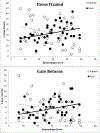Eye Tracking as a Marker of Hyperphagia in Prader-Willi Syndrome
- PMID: 29412007
- PMCID: PMC6139674
- DOI: 10.1080/87565641.2017.1367395
Eye Tracking as a Marker of Hyperphagia in Prader-Willi Syndrome
Abstract
This study examined the feasibility of eye tracking measures as markers of hyperphagia in 42 children and adults with Prader-Willi syndrome (PWS). Gaze data collected during free visual exploration of complex displays revealed that food images may not have an overall superior salience in PWS. However, increased attention to food in the context of other high-interest items was associated with higher scores on caregiver reports of hyperphagia. The study also provided preliminary evidence of test-retest reliability of eye tracking measures, suggesting that gaze characteristics may be a promising objective marker of food-related interests in PWS.
Figures
References
Publication types
MeSH terms
Grants and funding
LinkOut - more resources
Full Text Sources
Other Literature Sources
Medical


